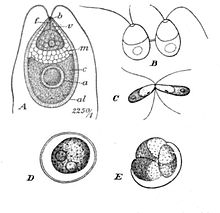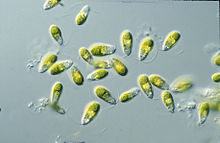
Back ዱናሌላ AM Dunaliella CEB Dunaliella German Dunaliella Spanish Dunaliella French דונליאלה HE Dunaliella Croatian Dunaliella IS Dunaliella Italian Dunaliella Portuguese
| Dunaliella | |
|---|---|

| |
| Dunaliella salina Teodor. A: Vegetative cell, B: Zoospores in cell division, C: Mating gametes, D: Ripe zygospore, E: Zygospore germination | |

| |
| Scientific classification | |
| Clade: | Viridiplantae |
| Division: | Chlorophyta |
| Class: | Chlorophyceae |
| Order: | Chlamydomonadales |
| Family: | Dunaliellaceae |
| Genus: | Dunaliella Teodoresco |
| Type species | |
| Dunaliella salina Teodoresco (Dunal)
| |
| Species | |
|
Dunaliella acidophila | |
Dunaliella is a single-celled, photosynthetic green alga, that is characteristic for its ability to outcompete other organisms and thrive in hypersaline environments.[1] It is mostly a marine organism, though there are a few freshwater species that tend to be more rare.[2] It is a genus in which certain species can accumulate relatively large amounts of β-carotenoids and glycerol in very harsh growth conditions consisting of high light intensities, high salt concentrations, and limited oxygen and nitrogen levels, yet is still very abundant in lakes and lagoons all around the world.
It becomes very complicated to distinguish and interpret species of this genus on simply a morphological and physiological level due to the organism's lack of cell wall that allows it to have malleability and change shape and its different pigments that allows it to change colours depending on the environmental conditions. Molecular phylogeny analysis has become a critical protocol in discovering the taxonomy of Dunaliella.[3] The genus has been studied for over a hundred years,[4] becoming a critical model organism for studying algal salt adaptation processes. It has remained relevant due to its numerous biotechnological applications, including β-carotenoid cosmetic and food products, medicine, and biofuel research.[5]
- ^ Oren A (December 2014). "The ecology of Dunaliella in high-salt environments". Journal of Biological Research. 21 (1): 23. doi:10.1186/s40709-014-0023-y. PMC 4389652. PMID 25984505.
- ^ Melkonian M, Preisig HR (1984). "An ultrastructural comparison between Spermatozopsis and Dunaliella (Chlorophyceae)". Plant Systematics and Evolution. 146 (1–2): 31–46. Bibcode:1984PSyEv.146...31M. doi:10.1007/BF00984052.
- ^ Preetha K, John L, Subin CS, Vijayan KK (November 2012). "Phenotypic and genetic characterization of Dunaliella (Chlorophyta) from Indian salinas and their diversity". Aquatic Biosystems. 8 (1): 27. doi:10.1186/2046-9063-8-27. PMC 3598838. PMID 23114277.
- ^ Petrovska B, Winkelhausen E, Kuzmanova S (1999-08-15). "Glycerol production by yeasts under osmotic and sulfite stress". Canadian Journal of Microbiology. 45 (8): 695–699. doi:10.1139/w99-054. PMID 10528402.
- ^ Hosseini Tafreshi A, Shariati M (July 2009). "Dunaliella biotechnology: methods and applications". Journal of Applied Microbiology. 107 (1): 14–35. doi:10.1111/j.1365-2672.2009.04153.x. PMID 19245408.